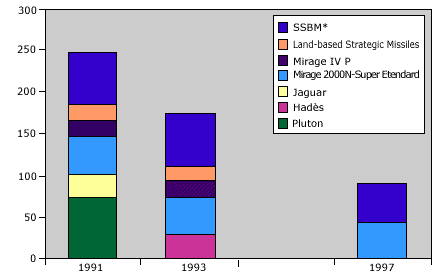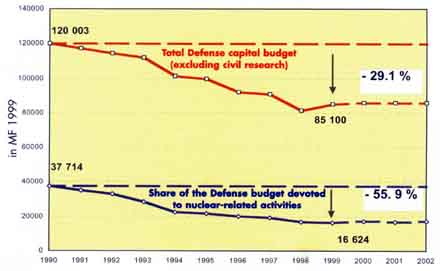





""We must take advantage of the respite offered by the current strategic situation to rethink our nuclear posture. The choice of our means must be based on the principles of sufficiency and credibility which have, moreover, always been ours ."Jacques Chirac, President of the Republic
at the Ecole militaire, Paris, 23 February 1996
French nuclear research began well before the second world war. In the period between the two wars, nuclear physics were already at a very advanced stage in France thanks to the work of Pierre and Marie Curie, Frederic Joliot-Curie and Irene Joliot-Curie. General de Gaulle had already been informed by various scientists of the progress made in American research in these matters and of its military implications. Thus, in autumn 1945, after the Hiroshima and Nagasaki explosions, he took the decision to create the Atomic Energy Commissariat (AEC).
The instability of the Fourth Republic in France after the war and the lack of financial means were to hold back French nuclear research which fell well behind that of the Americans. To some extent, American aid also prevented France from turning towards the military application of nuclear energy.
A first five-year plan for the development of atomic energy prepared by Felix Gaillard, a member of the Pinay government (March 1952 to January 1953) was mainly intended to find a remedy for the French energy deficit. The plan was to produce 50 kilos of plutonium a year which, in theory, would allow six to eight nuclear bombs to be produced.
On 5th December 1956, a Committee for the Military Applications of Atomic Energy was created secretly; this committee provided for co-operation between the Atomic Energy Commissariat and senior military officials. On 5th October 1956, there was an order for the establishment of a programme concerning vehicles of delivery. Finally, a program was outlined on 19th December 1956 for a future strategic nuclear bomb. The return of General de Gaulle after the crisis of 13th May 1958 marked the end of French indecision in these matters. The choices were clear; at the meeting of the Defence Council on 17th June 1958, he confirmed the date of the first French nuclear explosion and decided to accelerate the French nuclear program.
The first Soviet bomb exploded in 1949, that of the British in 1952, that of the French in 1960, and that of the Chinese in 1966. In parallel, these countries developed the vectors able to carry the bomb: planes initially, land-based missiles, then missiles launched by submarines.
In all, 41 tests in the atmosphere and 134 tests in boreholes in the atolls (from the edge of the atolls or in the central zone) were conducted between 1960 and 1991 on Mururoa and Fangataufa. Added to those in the Sahara, France had thus conducted a total of 192 tests up to 1992.
On 8th April 1992, President Francois Mitterrand, through his Prime Minister, announced the suspension of French nuclear tests that year. Thus started the French moratorium on nuclear tests which was renewed several times, finally to be suspended by the new French President, Jacques Chirac, in 1995. On 13th June 1995, as President of the French Republic, Mr. Chirac announced the resumption of nuclear tests by France; this was to be a final series of eight tests between September 1995 and May 1996. The French President announced simultaneously that France would carry out a final campaign of nuclear testing in the Pacific and that it would sign a universal and verifiable Comprehensive Nuclear Test Ban Treaty (CTBT). The last French nuclear test took place on 26 January 1996.Today the nuclear arsenals, although in reduction, remain very significant. The French concept is of showing the will and of having the capacity to make deter an adversary, by inflicting damage that is out of proportion with the stake of a conflict.
At the time of the Cold War, these doctrines were called "the dissuasion from weakness" and one spoke about the equalizing capacity of the atom. Today, the threat to French vital interests has declined. Thus, although France does not have an arsenal as large as at the time of the fall of the Berlin Wall, it retains a nuclear capability adapted to the current situation. This includes an underwater component equipped with 4 submarines launchers of machines (SNLE) embarking M45 missiles, and 3 squadrons of Mirage 2000 N as well as flotilla of Super Etandard (embarked on aircraft carrier) which can carry the ASMP missile.
As soon as the
Cold War was over, France renounced
developing programs (land-based S45 strategic missiles) and accelerated
the withdrawal of two systems (Pluton missiles*, AN-52 bombs*). It then
started scaling down its nuclear programs, whether they involved sea-launched
systems (new-generation SSBNs*), air-launched systems (Mirage 2000N
and ASMP* missiles), or ground-launched systems (Hadès* missiles).

In 1996, France adopted a further reduced format for its nuclear forces by scaling down its SSBNs* from five to four ; Mirage IVP bombers were withdrawn from service. Measures related to the de-alerting of nuclear forces were announced and implemented in 1992 and 1996.
| THE SHARE OF FRENCH DEFENSE BUDGET EXPENDITURES (EXCLUDING PENSIONS) RELATED TO THE NUCLEAR MILITARY EFFORT FELL FROM 16.9 TO 8.75% BETWEEN 1990 AND 1999. | |
 |
|
|
DE-TARGETING "Now that the plateau d'Albion land-based missiles have been stood down, no part of the French nuclear deterrent forces is any longer targeted;" Jacques
Chirac, President of the Republic |
|
By ratifying the Protocols to the Treaty of Rarotonga on 20 September 1996 and the Comprehensive Nuclear Test-Ban Treaty on 6 February 1998, France enshrined in legally binding international instruments the decision announced by the President of the Republic on 28 January 1996 to cease all nuclear testing.
|
|
Since the end of the Cold War, France is the only nuclear weapon State having dismantled all its test site facilities and given independent international experts access to its nuclear test sites. France is contributing to the international monitoring of the 1996 treaty by cooperating with the Comprehensive Nuclear-Test-Ban Treaty Organization in implementing the detection system (27 stations set up under France's auspices, 11 of which were set up in cooperation with other countries). |
|
DISMANTLING
OF FACILITIES FOR THE PRODUCTION OF FISSILE
MATERIAL FOR NUCLEAR WEAPONS
|
|
|
France is the sole nuclear power having announced and started the dismantling of its fissile material production facilities. Since 1992, France
no longer produces weapon-grade plutonium. |
 Gaseous diffusion uranium enrichment plant |
|
ASSISTANCE
IN THE DISMANTLING OF RUSSIAN NUCLEAR
WEAPONS (AIDA AND AIDA MOX)
|
| France has made a 70 million euro (FF460 millions) contribution to the dismantling of Russian nuclear weapons by providing machine tools, radiological equipment, containers and a storage building. A program was launched for the conversion of weapon-grade plutonium into MOX* fuel for civilian plants and is continuing in cooperation with Germany. |
|
3 June 1991 |
Comprehensive plan for arms control and disarmament |
|
11 September 1991 |
The President of the French Republic announced the early withdrawal of Pluton missiles* and AN52 bombs* and the early cessation of Hades missiles manufacturing |
|
8 April 1992 |
Moratorium on nuclear testing |
|
9 June 1992 |
First reduction of nuclear forces alert status |
|
2 August 1992 |
Accession to the NPT* |
|
24 August 1992 |
Ratification of Additional Protocol I to the Treaty of Tlatelolco* (Additional Protocol II was ratified on 22 March 1974) |
|
November 1992 |
Production of weapon-grade plutonium stopped |
|
12 November 1992 |
Agreement with Russia on the assistance in the dismantling of Russian nuclear weapons (AIDA*) |
|
5 May 1994 |
Public declaration by the President of the Republic on the nuclear arsenal |
|
6 April 1995 |
Declaration by the French representative to the Conference on Disarmament on the negative and positive security assurances* taken note of by UNSCR 984 |
|
13 June 1995 |
Announcement of the decision to complete the final nuclear test campaign in order to enable France to become a Party to the CTBT*. |
|
10 August 1995 |
France is the first nuclear weapon State to propose a true zero yield CTBT*. |
|
27 January 1996 |
Last and final French nuclear test |
|
23-23 February 1996 |
Announcement by the
President of the Republic of the permanent cessation of the production
of fissile material for nuclear weapons and of the permanent closing of
the Pacific Test Site facilities. |
|
February 1996 - May 1998 |
Study of the radiological situation in the Mururoa and Fangataufa atolls conducted by an international consultative committee of independent experts under the aegis of the IAEA* |
|
30 June 1996 |
Cessation of the production of highly enriched uranium for nuclear weapons |
|
20 September 1996 |
Ratification of the three Protocols to the Treaty of Rarotonga* (which were signed on 25 March 1996) and to the Treaty of Pelindaba* (which were signed on 11 april 1996) |
|
24 September 1996 |
Signature of the CTBT* |
|
23 June 1997 |
Last Hadès* missile destroyed |
|
25 September 1997 |
Announcement by the President of the Republic of the detargeting of the entire French nuclear capability |
|
6 April 1998 |
France, together with the United Kingdom, is the first nuclear weapon state to ratify the CTBT* |
|
2 June 1998 |
Signature of the French-German-Russian agreement on the dismantling of Russian nuclear weapons (AIDA* - MOX*) |
|
22 September 1998 |
Signature with the IAEA of an Additional Protocol to the Safeguards Agreement (strengthened Safeguards, 93+2* program) |
|
1988 |
Completion of the dismantling of the Pacific Test Site facilities (on August 1st), and of the Plateau d'Albion site ; S3D missiles destroyed (end of 1998) |
